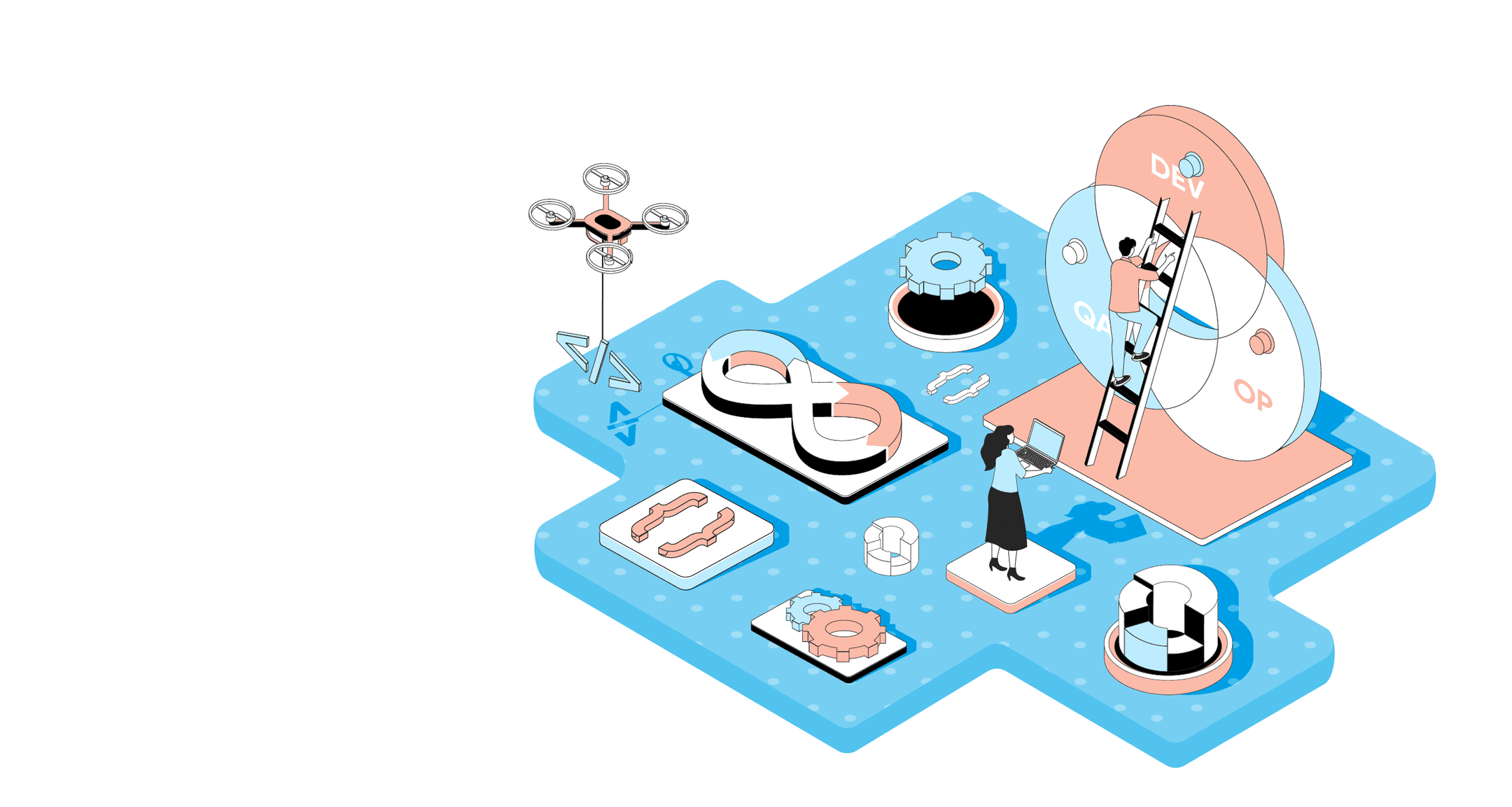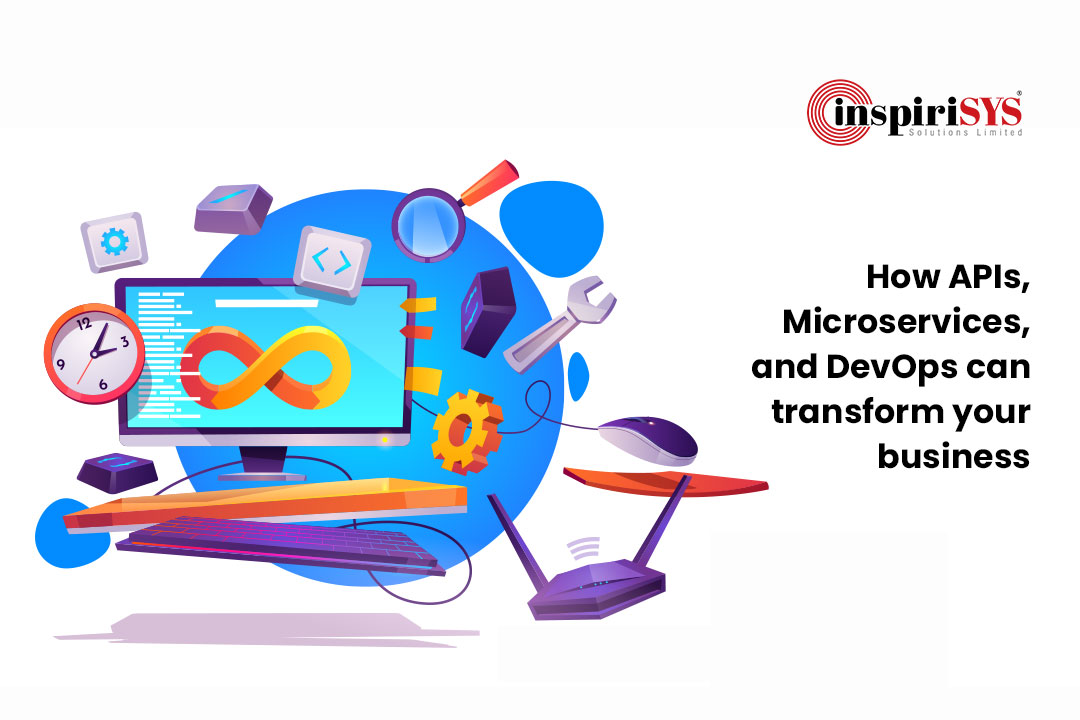Today’s competitive business climate demands organizations to take calculated risks and stand out from the crowd. To be successful in today’s digital economy, they need to scale faster, embrace and adapt to changes.
Having an innovative IT transformation strategy has become extremely critical for organizations to scale fast and grow successfully.
IT teams need to unlock its core systems using APIs, work with their development teams and empower them to build their own solutions. More and more organizations around the world are looking towards a combination of microservices, APIs and DevOps to transform their business. Once these assets start to grow, teams can become more self-reliant and drive new products to market faster.
What are DevOps and Microservices?
 DevOps is a methodology that allows developers and IT Ops to work together and deliver better quality software faster. It gives developers better insights into the production environment in which their software will run. This helps them improve the quality of the software.
DevOps is a methodology that allows developers and IT Ops to work together and deliver better quality software faster. It gives developers better insights into the production environment in which their software will run. This helps them improve the quality of the software.
DevOps is soon becoming an invaluable asset for enterprises and technology evangelists to do a quick and extremely effective implementation of the software development life cycle (SDLC). It is a transformative process that automates and organizes business processes, workflows, culture and methodology of an organization.This makes it a lot easier for them to achieve customer goals fast and efficiently.
The DevOps production environment could be simulated like it was in the early days. However, a simulated environment can never replicate the production environment completely. Organizations are moving their DevOps practices to the cloud, to replicate their production environment more accurately. This gives developers greater visibility into IT Ops and vice versa, reducing the traditional friction between the two roles.
Benefits of DevOps and Microservices
 DevOps breaks down software programs into smaller pieces. This increases the software delivery speed and quality. It stands out for its continuous practices. This includes continuous integration, continuous testing, continuous delivery, and continuous deployment, and enables the regular improvement of software products and software-related practices.
DevOps breaks down software programs into smaller pieces. This increases the software delivery speed and quality. It stands out for its continuous practices. This includes continuous integration, continuous testing, continuous delivery, and continuous deployment, and enables the regular improvement of software products and software-related practices.
Microservices based architecture is a software development technique that works as a Service Oriented Architecture (SOA). It results in smaller pieces of functionality and provides greater modularity than Agile or DevOps would.
As the name suggests, microservices are small pieces of functionality made available as a bigger service. They are independent building blocks which make it easier to create, test, use and understand applications. Multiple DevOps teams can build and deploy them in parallel. Microservices and containers are often used in both public and private cloud environments.
Microservices can also be easily deployed on any cloud API. This saves developers from writing platform-specific code, and also saves them significant time, money and resources.
Combining DevOps and Microservices for business transformation
Microservices enable continuous delivery and deployment. This accelerates the delivery of software. With most organizations moving towards the implementation of continuous delivery, new software needs to be released in a matter of months, weeks, or even days.
Continuous deployment of software can result in hundreds or thousands of releases every day. The modularity of microservices allows continuous, improved releases, which is the end goal of DevOps. When used together, DevOps and microservices can help:
-
Accelerate innovation
-
Make DevOps teams more productive
-
Cut down on errors
-
Reduce software development costs
-
Improve product quality
-
Drive higher levels of business value
Creating a pragmatic customized architecture through Microservices
Organizations with diverse requirements can benefit completely from microservices. What should they consider when looking to build their own custom blueprint for a microservices architecture? Here are some main factors:
Identifying the right tool for the job: A microservices architecture might not be the best fit for every application. Let's say an organization is heavily dependent on a legacy ERP application that has effectively supported important business processes for a long time. This organization needs to be sure that the rewards of switching to a microservices development approach will be higher than sticking to a legacy application.
Managing microservices with APIs: Microservices proliferate quickly by nature. Organizations might find them to be equally, if not more unwieldy than the monolithic applications they've been using. It becomes extremely vital to consider how microservices will be managed when a large number of small teams build apps and access business-critical data and systems regularly. An ideal way to manage them effectively can be through APIs, since each microservice will expose a managed API endpoint. This lets developers and business users innovate quickly while maintaining the right SLA, governance and security.
Integrating with legacy and SaaS apps: Larger organizations with more legacy systems and SaaS applications need to identify how these systems can be integrated with microservices. API-led connectivity can let them avoid large costs resulting from building point-to-point integrations.
Including APIs for digital transformation
 In order to realize a successful digital transformation, companies must first change their culture to include APIs, microservices and DevOps. For many businesses, this journey of transformation can take years. Organizations often add new APIs to applications at a later stage. Most leading organizations around the world have now started to appreciate the complexity associated with reorganizing their app processes due to the number of API products becoming available. These are particularly crafted to accommodate complex system-based situations and complex scenarios.
In order to realize a successful digital transformation, companies must first change their culture to include APIs, microservices and DevOps. For many businesses, this journey of transformation can take years. Organizations often add new APIs to applications at a later stage. Most leading organizations around the world have now started to appreciate the complexity associated with reorganizing their app processes due to the number of API products becoming available. These are particularly crafted to accommodate complex system-based situations and complex scenarios.
The future of Microservices, DevOps and APIs
In the long run, microservices will be an essential tool in meeting the accelerated pace of customer demand. However, organizations should make sure they don't fall for the hype and embark on its deployment without understanding what the right approach is. A one-size-fits-all approach rarely works in microservices development. Organizations must look at their own unique circumstances and figure out how they can get the most out of their microservices architecture.
Thriving enterprises have already begun to harness the power of DevOps for overcoming crucial bottlenecks of software development and the deployment process. The utilization of an effective DevOps strategy has accelerated the performance of businesses with its ability to develop, test, and deploy software a lot faster than other legacy enterprises.
Microservices and DevOps will undoubtedly have a major impact on your business. Additionally, here is a glimpse into how APIs have been faring:
-
Internal API economies are rising steadily. More organizations will start opening up their services to third parties using APIs to drive revenue, as far as possible by joining as many value chains as they can. Research says that Salesforce generates 50 percent of its revenue through APIs, while Expedia and eBay generate 90 and 60 percent through APIs respectively. This proves clearly that APIs are the real revenue drivers.
-
Banks are also starting to leverage APIs to build complete ecosystems around their product offerings. If they want to be part of the external API economy, organizations first need to establish an internal API economy.
-
Organizations can be more agile, deliver products and services cheaper and react to changing market conditions.
The role of APIs in securing enterprise data has become extremely important, but is often undervalued. APIs have been providing a single point of entry for all data sources by removing unwanted back doors. This makes it a great deal easier to move data around the enterprise and speed up overall efficiency.
In Conclusion
Application development and delivery have evolved from just being extensive project-based implementations. They now focus on continuous evolution. DevOps breaks the barrier between application development and IT operations. It brings business, development and operation teams together by applying automated processes to streamline IT. This helps the development and IT team to build, test and release software faster and more reliably.
Inspirisys Solutions Limited follows a design-led approach. This ensures DevOps is adopted in an integrated manner. We make sure our development and deployment processes are simple, programmable and dynamic. Our Integrated Delivery approach combines Agile Methodology, DevOps and Test Automation practices. This ensures complete life-cycle stability. This entire process improves organizations’ ability to deliver applications faster. At Inspirisys, DevOps work seamlessly in conjunction with microservices and APIs to accelerate the digital transformation of your business. Get in touch with us for top-class API, microservices, DevOps and other cybersecurity solutions.







